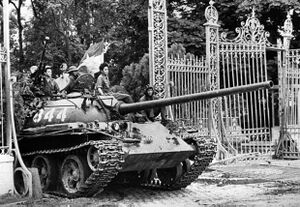War in Jalkolta
| War in Jalkolta | |||||||
|---|---|---|---|---|---|---|---|
 A Molvanian tank breaks through a fence during the Fall of Jalkoltic | |||||||
| |||||||
| Belligerents | |||||||
|
|
| ||||||
| Commanders and leaders | |||||||
|
|
| ||||||
| Units involved | |||||||
|
| |||||||
| Strength | |||||||
|
|
| ||||||
The Jalkolta War, known as the War of National Liberation by the post-war Jalkoltan government and commonlyt dubbed the Molvanian War in Balion, was a conflict in the nation of Jalkolta which took place from August 1947 to the Fall of Jalkoltic in April 1950. The war was fought primarily between the UMSR and the Republic of Jalkolta, which relied upon the support of the United States of Balion. The war took place in the direct aftermath of the Second Europan War following the Great Split, a breakdown of relations between the former Allied Powers and the North Europan Pact, which primarily found Molvani and Balion opposed to one another, with the support of their respective blocs.
Following several pro-leftist demonstrations in Jalkolta and the 1946 Jahovnik Uprising, the UMSR declared its support for the sizable leftist movement in Jalkolta. The UMSR presented the Jalkoltan government with an ultimatum in June 1947, ordering the government of Joseph Aodoin, which had taken power in the 1927 Jalkoltan Civil War to hold the first election in twenty-one years. Aodoin, aware that an election could see his government dethroned, refused, and, though the distracted Molvanian government seemed content to let the matter rest, Aodoin's violent suppression of a leftist student demonstration in the capital, Jalkoltic, provoked the Grand Presidium of the Union into declaring war.
Background
Invasion of Jalkolta
Jahovnik Landings
Molvani mobilised 100,000 men for the initial invasion, mostly new conscripts from the first draft since the Second Europan War. Organised into seven divisions, these troops were young, motivated and well-equipped but had no combat experience and were fresh from training. They were placed under the collective command of General Vladminir Puchkov, a veteran Red Army commander. A fleet of brand-new destroyers and cruisers, led by the loaned Vionna-Frankenlischian battleship HMNS Duke of Erin (serving as RNS Liberation in the Red Navy), conveyed the divisions to Jalkolta during a period of exceptionally calm seas and, after a twelve-day voyage, the fleet arrived off the coast of Jahovnik without incident.
Facing the invasion force were thirty-thousand Jalkoltan defenders. Mostly reserves from the Jalkoltan Guard, the force was bolstered by National Army battalions and local law enforcement. Though this force was mobilised in time to offer resistance to the landings, the first Molvanian troops came ashore unopposed on 28th August. Spearheaded by the 193rd Rifle Regiment, the landings gained ground swiftly and only stopped at midnight, having marched for three miles against Jahovnik. Landings continued throughout the night and, by the morning of 29th August, twenty-thousand men had come ashore. As day broke, however, the Molvanians found their route to Jahovnik blocked by troops of the Jalkoltan Guard backed up by Sheridan tanks of the 2nd Tank Regiment of the National Army. Led by the 193rd Rifles and the 204th Assault Regiment, the Molvanians attempted to break through the Jalkoltan defence at the Battle of Ihanokov but were repulsed with heavy casualties. A second attack later in the day was also repulsed with the loss of 800 men and 40 vehicles.